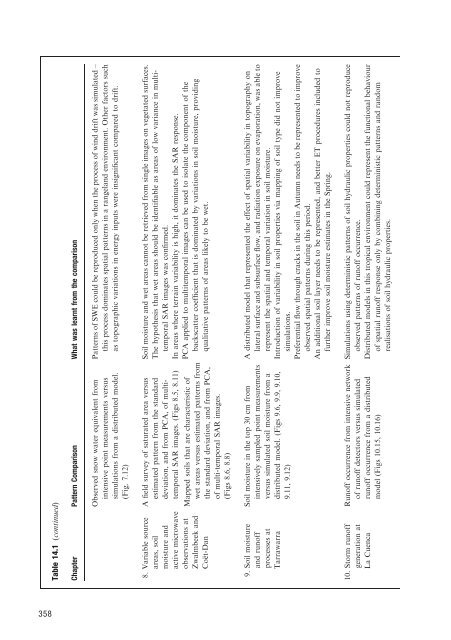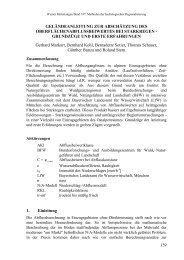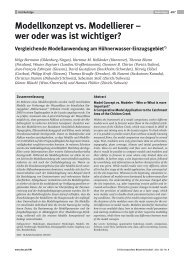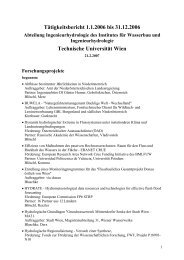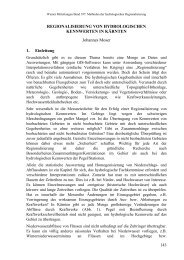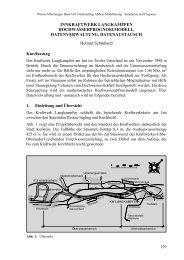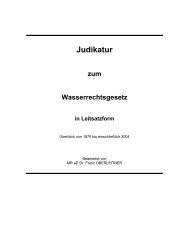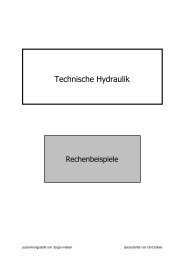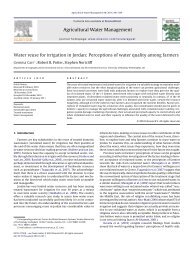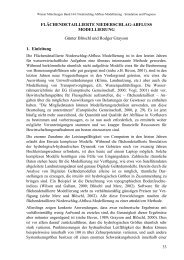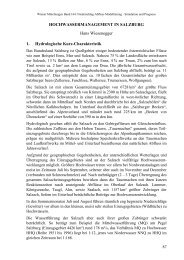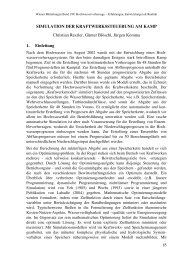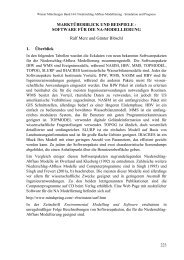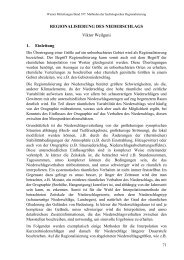Summary of Pattern Comparison and Concluding Remarks
Summary of Pattern Comparison and Concluding Remarks
Summary of Pattern Comparison and Concluding Remarks
Create successful ePaper yourself
Turn your PDF publications into a flip-book with our unique Google optimized e-Paper software.
Table 14.1 (continued)<br />
Chapter <strong>Pattern</strong> <strong>Comparison</strong> What was learnt from the comparison<br />
Observed snow water equivalent from<br />
intensive point measurements versus<br />
simulations from a distributed model.<br />
(Fig. 7.12)<br />
<strong>Pattern</strong>s <strong>of</strong> SWE could be reproduced only when the process <strong>of</strong> wind drift was simulated –<br />
this process dominates spatial patterns in a rangel<strong>and</strong> environment. Other factors such<br />
as topographic variations in energy inputs were insignificant compared to drift.<br />
8. Variable source A field survey <strong>of</strong> saturated area versus Soil moisture <strong>and</strong> wet areas cannot be retrieved from single images on vegetated surfaces.<br />
areas, soil<br />
moisture <strong>and</strong><br />
estimated pattern from the st<strong>and</strong>ard<br />
deviation, <strong>and</strong> from PCA, <strong>of</strong> multi-<br />
The hypothesis that wet areas should be identifiable as areas <strong>of</strong> low variance in multitemporal<br />
SAR images was confirmed.<br />
active microwave temporal SAR images. (Figs 8.5, 8.11) In areas where terrain variability is high, it dominates the SAR response.<br />
observations at<br />
PCA applied to multitemporal images can be used to isolate the component <strong>of</strong> the<br />
Zwalmbeek <strong>and</strong><br />
Coët-Dan<br />
Mapped soils that are characteristic <strong>of</strong><br />
wet areas versus estimated patterns from<br />
the st<strong>and</strong>ard deviation, <strong>and</strong> from PCA,<br />
<strong>of</strong> multi-temporal SAR images.<br />
(Figs 8.6, 8.8)<br />
backscatter coefficient that is dominated by variations in soil moisture, providing<br />
qualitative patterns <strong>of</strong> areas likely to be wet.<br />
9. Soil moisture<br />
<strong>and</strong> run<strong>of</strong>f<br />
processes at<br />
Soil moisture in the top 30 cm from<br />
intensively sampled point measurements<br />
versus simulated soil moisture from a<br />
Tarrawarra distributed model. (Figs 9.6, 9.9, 9.10,<br />
9.11, 9.12)<br />
A distributed model that represented the effect <strong>of</strong> spatial variability in topography on<br />
lateral surface <strong>and</strong> subsurface flow, <strong>and</strong> radiation exposure on evaporation, was able to<br />
represent the spatial <strong>and</strong> temporal variation in soil moisture.<br />
Introduction <strong>of</strong> variability in soil properties via mapping <strong>of</strong> soil type did not improve<br />
simulations.<br />
Preferential flow through cracks in the soil in Autumn needs to be represented to improve<br />
observed spatial patterns during this period.<br />
An additional soil layer needs to be represented, <strong>and</strong> better ET procedures included to<br />
further improve soil moisture estimates in the Spring.<br />
10. Storm run<strong>of</strong>f<br />
generation at<br />
Run<strong>of</strong>f occurrence from intensive network<br />
<strong>of</strong> run<strong>of</strong>f detectors versus simulated<br />
La Cuenca run<strong>of</strong>f occurrence from a distributed<br />
model (Figs 10.15, 10.16)<br />
Simulations using deterministic patterns <strong>of</strong> soil hydraulic properties could not reproduce<br />
observed patterns <strong>of</strong> run<strong>of</strong>f occurrence.<br />
Distributed models in this tropical environment could represent the functional behaviour<br />
<strong>of</strong> spatial run<strong>of</strong>f response only by combining deterministic patterns <strong>and</strong> r<strong>and</strong>om<br />
realisations <strong>of</strong> soil hydraulic properties.<br />
358


